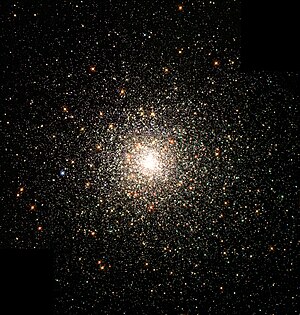
Back Messier 80 Afrikaans مسييه 80 Arabic Cúmulu globular M80 AST NGC 6093 Azerbaijani M80 (аб’ект Месье) Byelorussian M80 BE-X-OLD M80 Bulgarian Messier 80 BS Messier 80 Catalan NGC 6093 CE
| Messier 80 | |
|---|---|
 A Hubble Space Telescope (HST) image of M80 | |
| Observation data (J2000 epoch) | |
| Class | II[1] |
| Constellation | Scorpius |
| Right ascension | 16h 17m 02.41s[2] |
| Declination | –22° 58′ 33.9″[2] |
| Distance | 32.6 kly (10.0 kpc)[3] |
| Apparent magnitude (V) | 7.3[4] |
| Apparent dimensions (V) | 10.0′ |
| Physical characteristics | |
| Mass | 5.02×105[5] M☉ |
| Radius | 48 ly |
| Metallicity | = –1.47[6] dex |
| Estimated age | 13.5 ± 1.0 Gyr[7] |
| Other designations | M80, NGC 6093, GCl 39[8] |
Messier 80 (also known as M80 or NGC 6093) is a globular cluster in the constellation Scorpius. It was discovered by Charles Messier in 1781, being one of his first discoveries.[9]
This star cluster is, as to its angle from the solar system, midway between α Scorpii (Antares) and β Scorpii in a field in the Milky Way Galaxy that is rich in nebulæ. With low levels of light pollution it can be viewed below the 67th parallel north with modest amateur telescopes, appearing as a mottled ball of light.
It has an apparent angular diameter of about 10 arcminutes.[9] Since it is 32,600 light-years (10,000 pc) away, this translates into a true (spatial) diameter of about 95 light-years.[9] It contains several hundred thousand stars, and ranks among the densest globular clusters in the Milky Way.[9] It is at more than twice the distance of the Galactic Center in regions considered the Galactic halo.
It hosts relatively many blue stragglers, stars that appear to be much younger than the cluster. It is thought these have lost part of their outer layers due to close encounters with other cluster members or perhaps from collisions between stars in the dense cluster. Images from the Hubble Space Telescope have shown pronounced districts of these stragglers in M80, suggesting the center of the cluster to have a very high capture and collision rate.[9]
On May 21, 1860, a nova was found in M80 that delivered a magnitude of +7.0 to telescopes, binoculars and astute eyes.[9] This variable star, given designation T Scorpii, reached an absolute magnitude of −8.5, briefly outshining the cluster.[9]
- ^ Cite error: The named reference
hcob849_11was invoked but never defined (see the help page). - ^ a b Cite error: The named reference
aj140_6_1830was invoked but never defined (see the help page). - ^ Cite error: The named reference
aj139_2_476was invoked but never defined (see the help page). - ^ "Messier 80". SEDS Messier Catalog. Archived from the original on April 30, 2022. Retrieved April 30, 2022.
- ^ Cite error: The named reference
apj742_1_51was invoked but never defined (see the help page). - ^ Cite error: The named reference
mnras404_3_1203was invoked but never defined (see the help page). - ^ Göttgens, Fabian; Kamann, Sebastian; Baumgardt, Holger; Dreizler, Stefan; Giesers, Benjamin; Husser, Tim-Oliver; Den Brok, Mark; Fétick, Romain; Krajnovic, Davor; Weilbacher, Peter M. (2021). "Central kinematics of the Galactic globular cluster M80". Monthly Notices of the Royal Astronomical Society. 507 (4): 4788–4803. arXiv:2108.11393. doi:10.1093/mnras/stab2449.
- ^ Cite error: The named reference
simbadwas invoked but never defined (see the help page). - ^ a b c d e f g "Messier 80". SEDS Messier Database. Students for the Exploration and Development of Space. Archived from the original on January 14, 2022. Retrieved December 19, 2021.
© MMXXIII Rich X Search. We shall prevail. All rights reserved. Rich X Search
![{\displaystyle {\begin{smallmatrix}\left[{\ce {Fe}}/{\ce {H}}\right]\end{smallmatrix}}}](https://wikimedia.org/api/rest_v1/media/math/render/svg/4c0821bd80891e071c08e7c7ee8e022baedf522c)